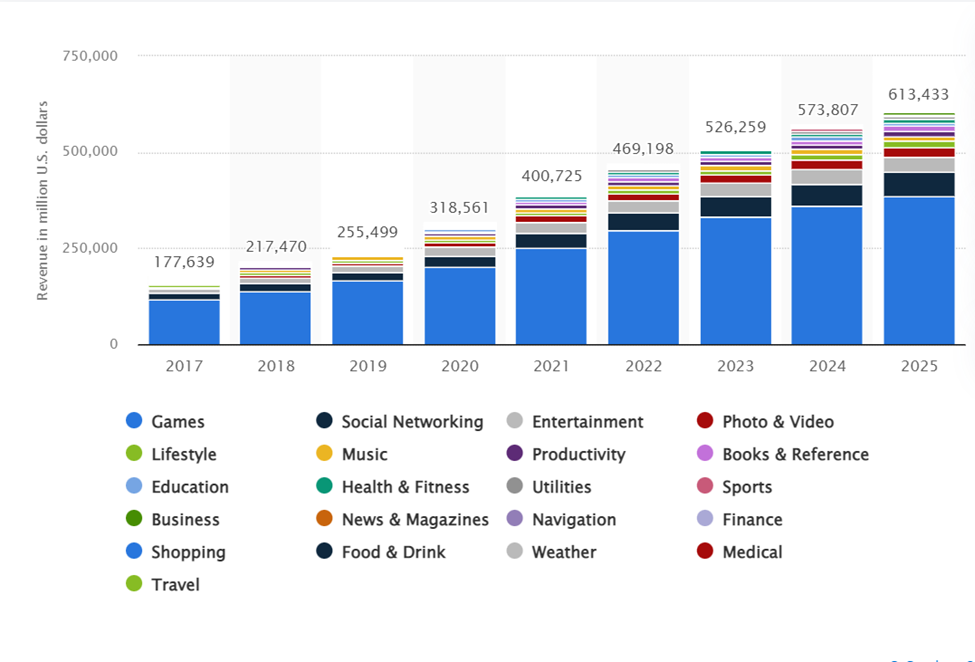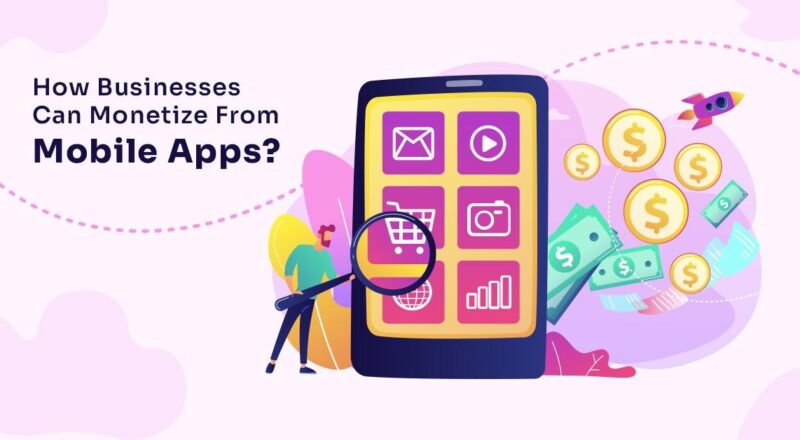“In today’s modern world, people are either asleep or connected.” – Janice H. Reinold.
It proves that mobile phones are everywhere from the moment people get up in the morning to the last thing they interact with before sleeping. As mobile apps have become a fabric of day-to-day life, businesses are using the digital hub to bridge the physical world and earn galore.
The leading players have experienced that mobile apps are providing enormous opportunities to promote business online and gain a strong foothold in the competition. The ROI statistic that makes your head spin, that mobile app revenue is expected to increase to $613,433 by 2025 worldwide.

The rapid growth of mobile app usage at an alarming rate enables businesses to capitalize either by improving the user experience or leveraging other monetization strategies.
The monetization strategies work only when the mobile app features work flawlessly, are easily accessed, and deliver the best experiences through interaction-focused design. It makes perfect sense to stay relevant to the market and users’ preferences.
What is a monetization strategy?
The monetization strategy is a plan that defines ways to generate revenue from mobile applications. It showcases how active users are turned into potential users and various opportunities to earn tangible revenue from them. Different monetization strategies fit well different types and size of mobile applications. Effective web design can help you create a mobile app landing page that converts visitors into users and paying customers. There is no one-size-fits-all solution. Businesses should refer to this mobile app monetization guide before experimenting with any monetization strategy.
Which are the monetization trends that allow businesses to earn from mobile apps?
Freemium model
The freemium model is the most common monetization model that’s highly leveraged in developing nations, wherein the applications are available for free to download. The users can install the free apps and use them with some limitations. Backend solutions for mobile apps can help you generate revenue from your app through in-app purchases, subscriptions, advertising, and other monetization strategies. The features and design available at no cost are engineered in a way that showcases the core of the app and persuades the users to pay for using premium features. The revenue earned from premium features enables businesses to continuously render the best experiences.
YouTube is the best instance of the freemium model where users can download the app and view unlimited videos. The premium version facilitates the ad-free experience and keeps playing video or music when another page is opened or the screen gets locked. It urges interested users to pay extra for improved experiences.
Pay-to-download model
The reverse of the freemium model is the pay-to-download model that involves paying for downloading the app. The users need to pay only once for downloading the app and accessing the complete functionalities. Businesses need to showcase the app’s purpose and the value it delivers because users resist buying the app that they have not tried even once. Creating mobile apps using AI can help you make money from mobile apps by automating tasks, and reducing development costs. Also, when the free alternatives of the app are available, then nobody will prefer to pay for downloads.
When the pay-to-download model is selected, the business needs to be ready beforehand with specialties that make the app unique. Initially, put the apt price tag for mobile apps that users pay willingly and allow businesses to earn optimally.
In-app purchase
The businesses that have kept the app available free to download can use the in-app purchase as a monetization strategy to earn revenue. It’s widely used in game apps and entertainment apps at scale. It includes the users can download the app for free, but accessing additional features, content, or in-game currency requires them to pay more dollars. Other than game apps, in-app purchase is popular in social networking, dating, and education apps.
The in-app purchases involve buying and renewing the subscription for services, repetitively buying in-game currencies when they are consumed, and accessing non-consumable features that are used anytime, anywhere.
In-app ads
The investment in advertisement is increasing worldwide because of the astronomical rise in business ROI. The well-known in-app ads monetization model brought a bunch of advantages with versatility. It involves the business allowing other brands to put their ads on the app at different positions and pages. Renting the app’s space brings a consistent stream of revenue from the brands.
Different types of in-app ads are facilitated to the brands to gain exposure, traffic, and leads for their products/services. Native ads seamlessly blend with the app’s interface and content that appears natural to the users. Banner ads are posted in the form of images that direct the users from one app to another platform. Reward ads require users to watch a video or perform a desired action to get points of extra lives in the game apps. Instagram has used in-app ads fairly that appear natural to the users.
Data monetization
Mobile apps are generating petabytes of data through users’ form submission, browsing behavior, clicks, subscriptions, and a lot more. The data when organized and analyzed, it generates rich insights that are valuable for the businesses to up the personalization game, which, in turn, helps in increasing conversion and retention. It improves the bottom line.
Additionally, the data is also sold to third parties for promoting the businesses and recommending the tailored offerings to the customers. The data selling brings optimal revenue to the businesses.
Subscription
The revenue from subscription services increased to $15.5 million globally and 78% of iOS users are responsible for generating this much revenue from subscription-based services. The monetization model has also uplifted the app store revenues by a large fraction.
The model involves users paying monthly, quarterly, or yearly to continuously enjoy using services, products, or content hassle-free. Some mobile apps facilitate a free trial of a week or 15 days before they subscribe for the services so that they get a chance to try the app. Netflix is the best example of the subscription-based model that provides a free trial period to experience the services and then users can subscribe for the same.
Affiliate marketing
It involves allowing other brands to promote their offerings on the mobile apps based on the revenue-sharing model or CPC model. When the mobile app user visits the affiliates link or performs an action, the users earn a reward under the CPC model. The revenue sharing model includes the mobile app owner will receive a percentage of profit from the affiliate’s earnings from the app.
Most mobile apps are using affiliate marketing as their monetization model that’s bringing passive income to them. Amazon Associates is a popular example of affiliate marketing that allows app publishers to make huge revenue only by placing a link of Amazon wares as an advertisement.
Conclusion
Wendy Clark, former SVP at Coca-Cola said, “If your plans don’t include mobile, your plans are not finished.”
Her words stand true by looking at the revolutionary role they have played in the people’s lives. Businesses need to be abreast of technological developments and the way people respond to them to stay on the top of the business ROI.
Various app monetization strategies can help businesses make money through the app that performs well. The right monetization strategy or a combo of one or two monetization strategies is imperative to achieve the desired ROI goals. The businesses should consider different factors such as app genre, target audience, unique features, services rendered, and user engagement level before the monetization model selection so that the app steers ahead in the right direction.My two cents: Beware! The app’s success lies in making the customer happy and satisfied. If the idea of turning the app into the revenue-generating machine using monetization models won’t move ahead in a balanced way, then it ruins the user experience and existing users start looking to the competition. Choose the app monetization strategy prudently that takes the business forward.
